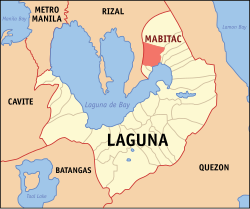Mabitac | |
|---|---|
| Municipality of Mabitac | |
 Mabitac Poblacion | |
 Map of Laguna with Mabitac highlighted | |
Location within the Philippines | |
| Coordinates: 14°26′N121°25′E / 14.43°N 121.42°E | |
| Country | Philippines |
| Region | Calabarzon |
| Province | Laguna |
| District | 4th district |
| Founded | January 6, 1616 |
| Barangays | 15 (see Barangays) |
| Government | |
| • Type | Sangguniang Bayan |
| • Mayor | Alberto S. Reyes |
| • Vice Mayor | Ronald I. Sana |
| • Representative | Benjamin Cueto "Benjie" Agarao Jr. |
| • Municipal Council | Members |
| • Electorate | 14,935 voters (2025) |
| Area | |
• Total | 80.76 km2 (31.18 sq mi) |
| Elevation | 128 m (420 ft) |
| Highest elevation | 726 m (2,382 ft) |
| Lowest elevation | −1 m (−3.3 ft) |
| Population (2024 census) [3] | |
• Total | 21,748 |
| • Density | 269.3/km2 (697.5/sq mi) |
| • Households | 5,022 |
| Economy | |
| • Income class | 5th municipal income class |
| • Poverty incidence | 9.79 |
| • Revenue | ₱ 139 million (2022) |
| • Assets | ₱ 280.9 million (2022) |
| • Expenditure | ₱ 115.8 million (2022) |
| • Liabilities | ₱ 79.29 million (2022) |
| Service provider | |
| • Electricity | First Laguna Electric Cooperative (FLECO) |
| Time zone | UTC+8 (PST) |
| ZIP code | 4020 |
| PSGC | |
| IDD : area code | +63 (0)49 |
| Native languages | Tagalog |
| Website | www |
Mabitac, officially the Municipality of Mabitac (Tagalog : Bayan ng Mabitac), is a municipality in the province of Laguna, Philippines. According to the 2024 census, it has a population of 21,748 people. [5]









